Due to the rise of social isolation and the growth of the home-based economy, an increasing number of businesses are transitioning online, creating over 1.5 billion websites worldwide. The low barrier to entry and the availability of various website creation tools make it easy to create a business website, even without extensive programming knowledge.
A dedicated website provides several advantages over social media channels like Facebook and Instagram, as it allows you to showcase all of your brand elements and provides a consistent stream of information to potential customers, influencing their purchasing decisions.
A business website offers a range of benefits, such as publishing news and updates, offering:
- Posting news and updating information
- Offer discounts and run promotions
- Give your address and contact information
- Allow customers to contact you through some kind of contact information
- Show what you have to offer
- Showcase your products
- Generate sales leads
To assist you in getting started, I’ve created a comprehensive eight-step guide that teaches you how to create a website using various tools, including WordPress, SEMRush, and Wix. This ultimate cheat sheet covers everything from website planning and development to launching your site and attracting your first customers.
1. Plan Your New Website
2. Select Domain Name and Logo
3. Design Your Website
4. Start a Website By WordPress
5. Get Free Images & Pictures
6. Create a Blog Channel for the Website &Create Great Content
7. Promote Your Website-SEO
8. Build an Email List
Let’s begin!
1. Plan Your New Website
The saying, “If you have a goal and no plan, everything is a pipe dream,” emphasizes the importance of having a plan before pursuing any goal, including building a website.
Just as investing requires careful planning, website development also demands a thorough investigation of all aspects. Planning is essential in designing website elements and should not be overlooked.
During the planning phase, it's important to brainstorm and consider the following aspects:
- Essential pages and sections of the website (sitemap)
- The main focus area of the website
- Themes to be covered
- Design and color scheme considerations
- Necessary headers and subheaders
- Design of headers, footers, subpages, and sidebars
- Home page images and messaging
Drawing a mind map of the entire website production process can be an effective way to plan. This enables you to visualize the website structure and cohesively organize ideas.
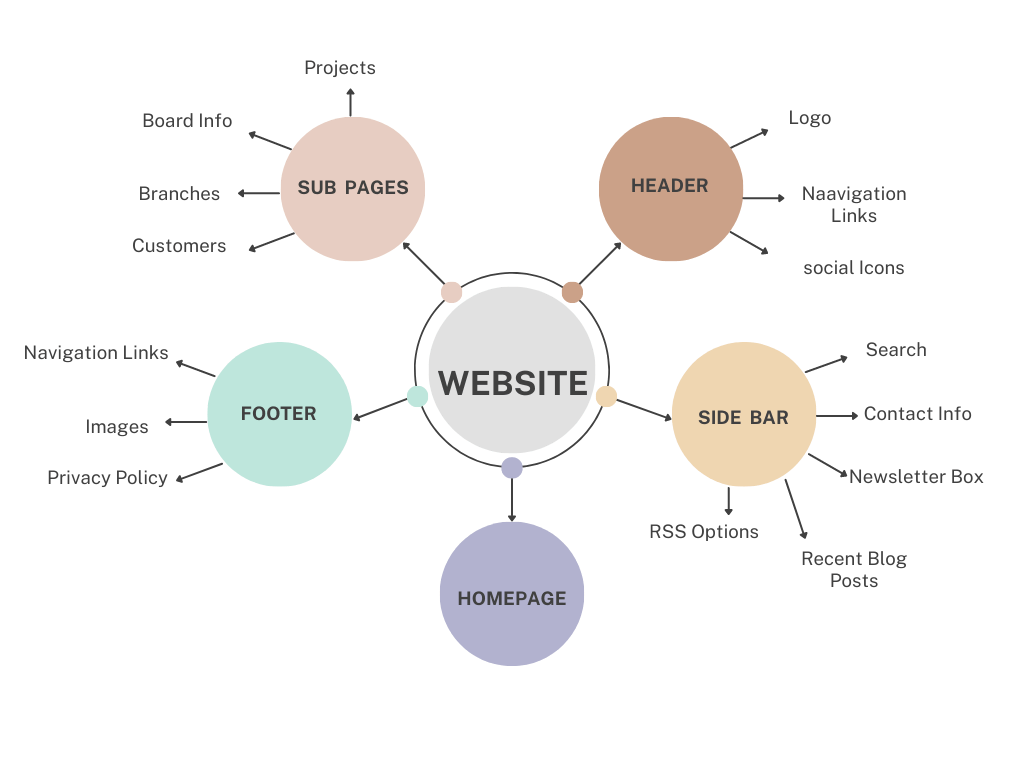
Here are a few steps to help you reach this goal:
1. Briefly describe the page you want to put on your website.
2. Visit and carefully study the websites of your peers and direct competitors. For example, suppose you want to open a new store. In that case, you should ask around among your target customers and find your competitors’ websites. Then look at their message posting methods, layout, and pricing.
3. Start a new spreadsheet and jot down the keywords you want to target, the pages you need, your audience, and the unique value proposition.
4. Do an SEO search for the keywords and also find out how you can embed those keywords into your site to get more organized traffic. This has been discussed in depth in my Ultimate Tips for Newbies blog.
Remember, visitors are impatient, and it’s important to tell them what your site is for at a glance.
For example, you don’t need to put sesquicentennial information on the homepage. It would help if you used eye-catching headers, subheaders, and call-to-action (CTA) mechanisms to give visitors the information they need quickly.
Make sure to complete the planning process, websites evolve and change over time.
Once you’ve figured out what pages and keywords you need to target, you’re ready to take the next step.
2. Select Domain Name and Logo
Your website needs a name and brand identity to differentiate it from competitors. With over 500,000 brands worldwide in more than 2,000 categories, standing out can be challenging.
However, a unique domain name and logo can help create a lasting impression on your audience. Thankfully, many website creation tools are available to help you add branding elements easily.
Siteground is an excellent platform for registering your domain name and hosting your website. If you’re building your site with WordPress, their built-in installation module can significantly simplify the process.
Alternatively, if you already have a domain name from a third-party provider like Bluehost or Namecheap, you can also use it.
A personalized domain name can create trust, instill customer confidence, and help you build brand recognition. Over 366.8 million domain names were registered worldwide in Q1 of 2020, highlighting their importance.
In addition, make sure your domain name is:
- Short and small
- Simple
- Easy to remember
- Professional
- Leave a deep impression
A logo is a key branding element and an essential differentiator in the marketplace. To create an effective logo, consider your business focus, personal style, target audience, industry, and medium. Canva provides hundreds of logo templates and samples for inspiration. You can customize the colors, fonts, text, and size until satisfied.

Some characteristics of the best logos:
Simplicity – It must be easy to understand and easy to associate with.
Appropriate – the logo must be relevant to the business and the problem you are trying to solve.
Easy to remember – the logo should leave an impression in customers’ minds so they can recognize it in the marketplace.
Timeless – The effectiveness of the logo’s design should stay strong over time. For example, the McDonald’s logo has remained unchanged over the years.
Broadly applicable – The logo should evoke the same recognition and respect, regardless of size or medium.
A logo that meets these characteristics will leave a lasting impression in customers’ minds, regardless of size or medium.
Once you have your domain name and logo, it’s time to focus on the layout and design of your website.
3. Design Your Website
Your website is often the first interaction potential customers have with your business, so it’s important to make an excellent first impression through the design and layout of your website. Research shows that 75% of a website’s reliability comes from its design.
Here are some tips for designing a great website:
1. User-Friendly and Mobile-Friendly
Your website should have an intuitive interface and be mobile-optimized, as most people spend 70% of their online time on mobile devices. A clear Call to Action (CTA) button can direct users to where you want them to go.
2. Customizable
Customizability can differentiate you from your competitors and create visual appeal, which is important as 66% of people prefer to see something beautiful online rather than a thousand pages of mundane content.
3. Fast Loading Time
Slow loading times are a common problem for websites, with 53% of users leaving a mobile site if it fails to load within three seconds. Use tools like PageSpeed Insights to analyze your website and improve loading times.
4. Use the Right Visuals
Adding visuals, such as videos, can increase customers’ time on your site by 88%. When choosing a website design, prioritize clear navigation, directing visitors to the home page, using white space, checking for errors, maintaining uniqueness, and using personal rather than gallery images.
Remember, your website is often the first impression potential customers have of your business, so it’s essential to make it count.
When building a website, it’s crucial to have a clear action plan and know what pages are essential for your business. While every merchant is unique, certain pages are more important than others.
Here are five pages that should be included in any website:
Home Page
The home page is typically the first page visitors see when they arrive at your website, so making a good impression is crucial.
The home page should include your brand’s name, logo, and a clear description of what your business does. The design should be visually appealing, and the navigation structure should be easy to use to guide visitors to the necessary pages.
In addition, the home page should contain critical information about your brand, such as features and differentiators.

“About Us” Page
The “About Us” page is an essential component of any website, as it’s where you can tell your story and build a personal connection with your audience.
You can highlight your mission, core values, and the problems you want to solve. Personal touches like photos of team members can help make your brand more relatable and trustworthy.
Service/Product Pages
Service and product pages are where you sell your products or services. These pages should be visually appealing and convincing to visitors that your business is better than your competitors. High-quality product images, clear descriptions of features, and real buyer reviews are all effective ways to showcase your products or services.
Also, ensure these pages are mobile-friendly and provide a secure payment process.
Contact Page
Make it easy for customers to reach you by providing detailed contact information, including phone numbers, email addresses, postal codes, and social media accounts. You can also add features like live chat to improve the customer experience.
Blog Posting
Regular blogging can help improve your search engine rankings, create your niche in the marketplace, and drive traffic to your website. Make sure your blog posts provide value to your readers by helping them with specific activities and solving specific problems.
While these are five essential pages for any website, conducting thorough market research is important to understand what pages are indispensable for your business. You can also evaluate your competitor’s websites to determine what pages are important to them. By doing so, you can create a website that meets your business’s unique needs and objectives.
4. Start a Website By WordPress
Installing WordPress
Self-hosted WordPress is the best website platform for you.
The good news?
Siteground automatically one-click installs WordPress right from your hosting dashboard, making starting a blog a piece of cake.
Using the Website Setup Wizard to Install WordPress is the best way.
To install WordPress using the Website Setup Wizard, access your Client Area and click the Websites > New Website button.
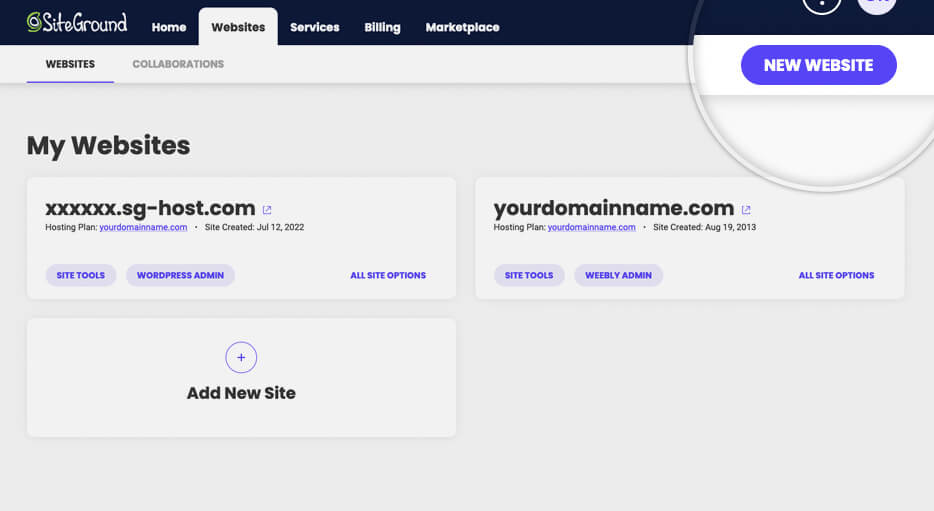
A new section would appear where you will be prompted to select the domain name that you want to use with your new WordPress installation.
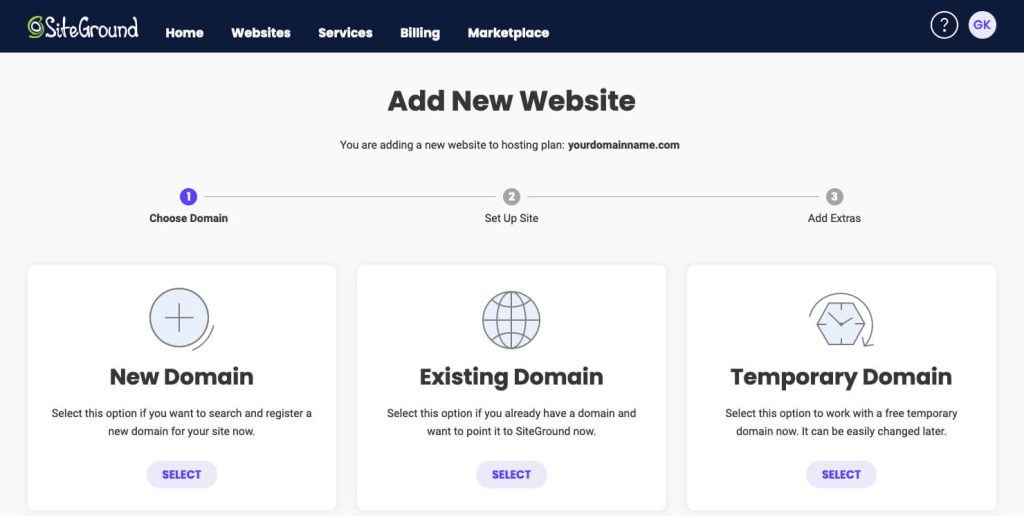
Click the Continue button once you have chosen the desired option to proceed to the next step.
In this next step, you should select to Start a New Website or to Migrate an existing one. Click on Select under Start New Website.

Choose WordPress and enter the preferred login details for your new WordPress application. Once you are ready, click on Continue.
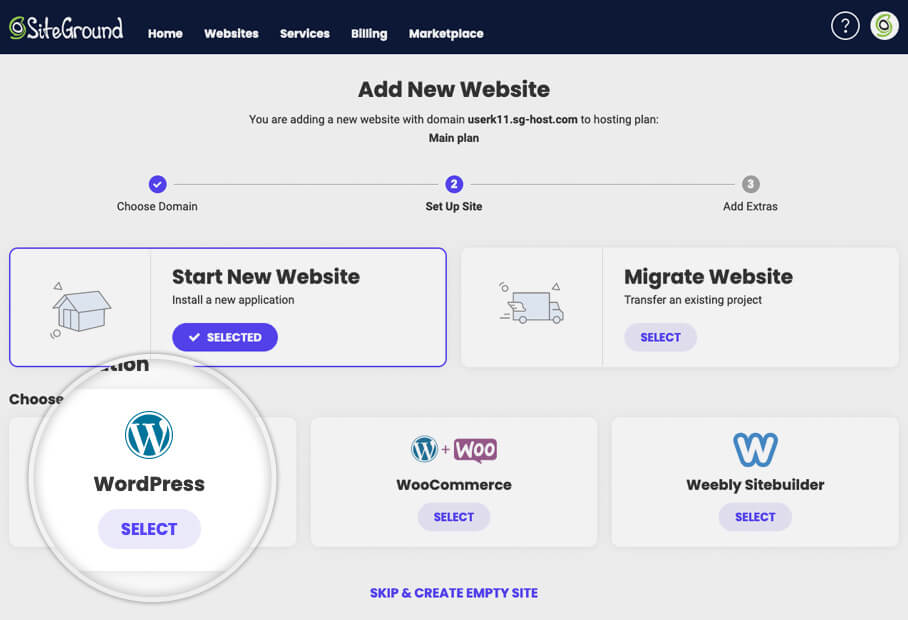
Next, choose what enhancements you wish to add to your website – if you want to add any. When you are ready with this step – click on Finish.
That’s it! You can now go to your site’s front page or access the WordPress admin to start adding content to your website.
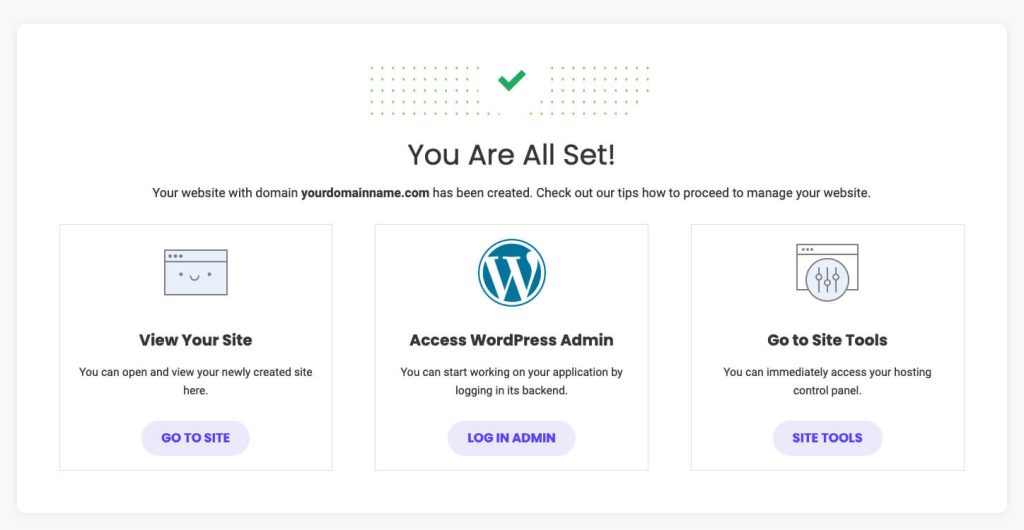
Are you ready to start your website? Get started for just $1.99/month (86% off your wordpress hosting plan) with my link below:
Pick a Theme for Your Website
Your website’s design is determined by a combination of templates, files, and stylesheets, forming a WordPress theme together.
The default WordPress theme is in use on new website , and a menu on the left can be used to modify its appearance.
When choosing a WordPress theme, you have two options: free or paid. Free themes come with limited options, while paid ones offer more features.
As a website recommendation, I suggest picking a theme like WP Astra or Blocksy, which are considered the best options.
Here's how you can install a new theme for your WordPress blog:
First, log in to your WordPress account (admin page).
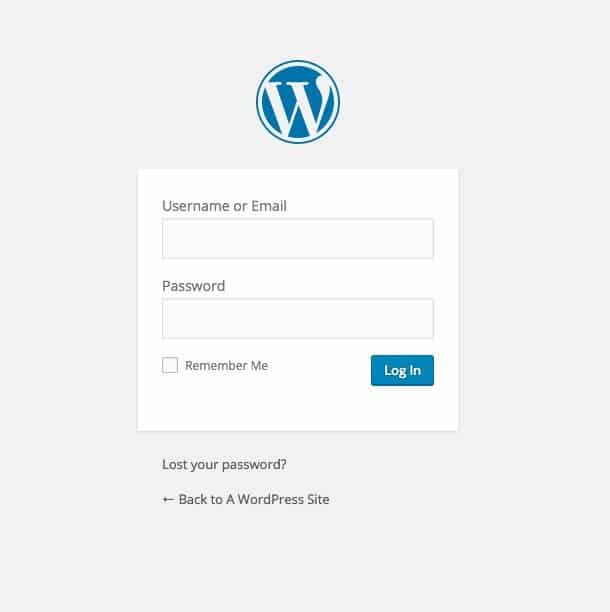
You can always access your WordPress login page by going to yourdomainname.com/wp-admin.
Once logged in, your WordPress dashboard looks something like this.

Here, click on the “Appearance” option from the sidebar menu.
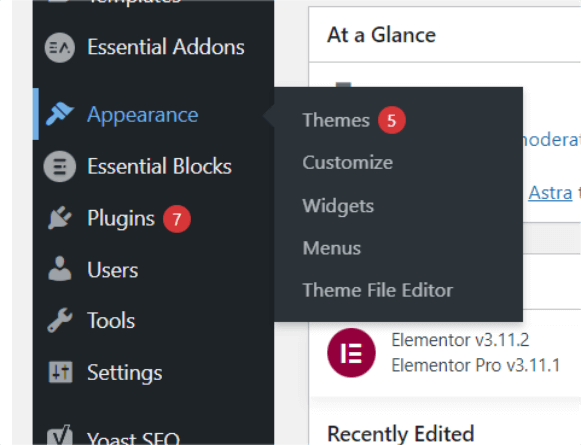
Next, select the “Themes” option from the “Appearance” section.
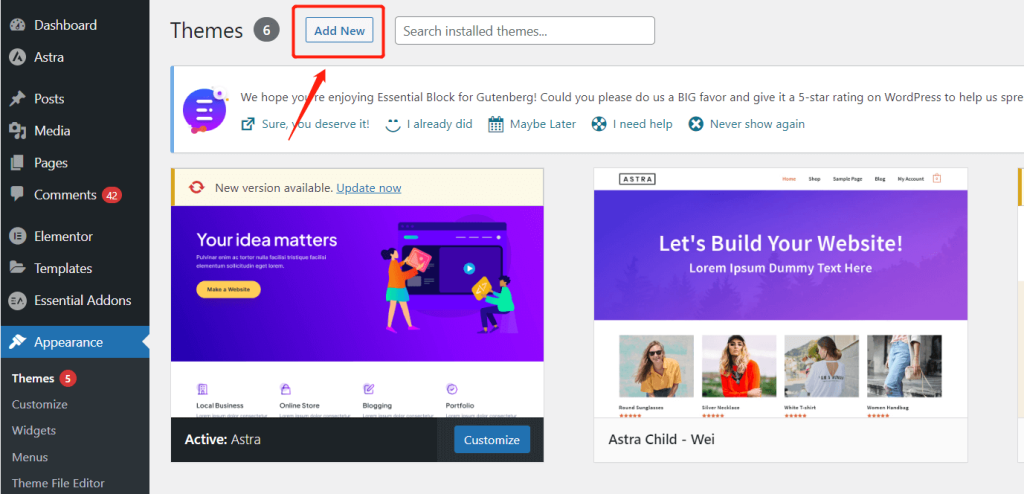
To search for WordPress’s theme options, click the “Add New” button at the top of the page.
As you can see below, there are many free themes.

Before picking one for your blog, preview as many WordPress themes as possible.
To install an external theme from a site like ThecmeIsle, go to “Appearance” – “Themes” and click “Add New,” upload the zip file, and click install.
Ready to launch your website and follow along with this guide? Get started for $1.99/month and get 86% off your website hosting plan:
Install Simple WordPress Plugins
Plugins are useful tools that can enhance your website’s functionality and features.
For website starting out, selecting the right plugins for search engine optimization (SEO) and site speed can significantly impact the success of their website.
If you want to improve your blog’s performance, here are four top plugins you should consider adding:
1. Elementor Pro
This WordPress landing page builder can help you create stunning home and about pages. While there is a free version available, the Pro version offers even better templates.
2. ShortPixel Image Optimizer
This tool compresses your images and screenshots, which can reduce file sizes and help your pages load faster. After testing many image compression tools, this one stands out as the best.
3.WP Rocket
WP Rocket is an all-in-one site speed plugin that can simplify your website’s code, integrate with your CDN, reduce database size, and more.
4. Yoast SEO
This plugin can help you manage your website sitemap, robots.txt file, page titles, and meta descriptions. If you prefer an alternative, AIOSEO is also a good option.
5. Get Free Images & Pictures
Almost every web page needs images. Images are required for homepages, subpages, landing pages, celebrity influencers, and more. So it would help if you had a lot of alluring pictures and other kinds of images.
Luckily, various sites offer free gallery treasures. You can buy it or get it for free. Generally speaking, new merchants will save extra costs by using free photo galleries.
However, when using free stock images, it is important to be careful only to use public domain stock images. Otherwise, your business may be subject to infringement lawsuits.
Here are some great free stock photo sites:
1. Unsplash
Offers some free stock photos, some of the best. Themes generally involve joy, love, flowers, and so on.
2. Pexels
This site has a wide range of images. Common themes include energy, movies, sunglasses, love, leaves, weight loss, and more.
3. Pixabay
Provides over 1.7 million free images on various topics such as nature, religion, festivals, people, love, and more.
4. Gratisography
This is an excellent collection of free images on topics ranging from animals, nature, and urban to rural divide.
5. New Old Stock
A unique site that features free images sourced from public archives for the purpose of depicting history. The themes it focuses on include art, customs, lifestyles, livelihoods of predecessors, etc., with a retro atmosphere.
You can find many other great sites that offer free stock photos. These sites have a steady supply of images.
6. Create a Blog Channel for the Website &Create Great Content
Website content is one of the most critical factors that send ranking signals. There is no doubt that search engines rely heavily on your content.
If you want your small website to have a long-term future, please be sure to do the following three things correctly:
- Unique content
- Regularly updated
- Provide value to the target audience
The more you write, the better your chances of getting traffic to your website. You have to write more than your competitors to surpass them and reach the top SEO rankings.
So, how long should a blog post be? All blog posts you write must be highly relevant, descriptive and provide value to your readers. So short blog posts are mostly useless. Blog posts should directly address and solve the problem.
Someone once investigated the optimal length of the most exposed blog posts, which proved to be the case.
So obviously, all blog posts on the first page of Google are over 2000 words.
When you write your first blog post (and every one after that), you should list at least the top 5-10 keywords (topics) you want to cover.
When planning your content strategy, consider what your reader wants when performing an online search for your target keyword.
It’s also essential to write content that matches Google search intent and compels them to take action on your blog.
SEMrush and BuzzSumo are great tools for researching markets and analyzing readers.
You can also use tools like Google Trends and social media analytics to better understand market trends and consumer behavior.
For instance, if you target the “Apple AirTag,” SEMrush can help you identify related keywords’ competition, search volume, and other indicators.

Match search intent and provide the solution your readers are looking for by understanding the meaning behind their search.
Incorporating a variety of content formats, such as text, images, and videos, can enhance your presentation and engage your audience.
While you don’t have to be a professional writer when starting a blog, it’s essential to understand basic sentence structure and proper grammar.
You can use Grammarly to check your writing.
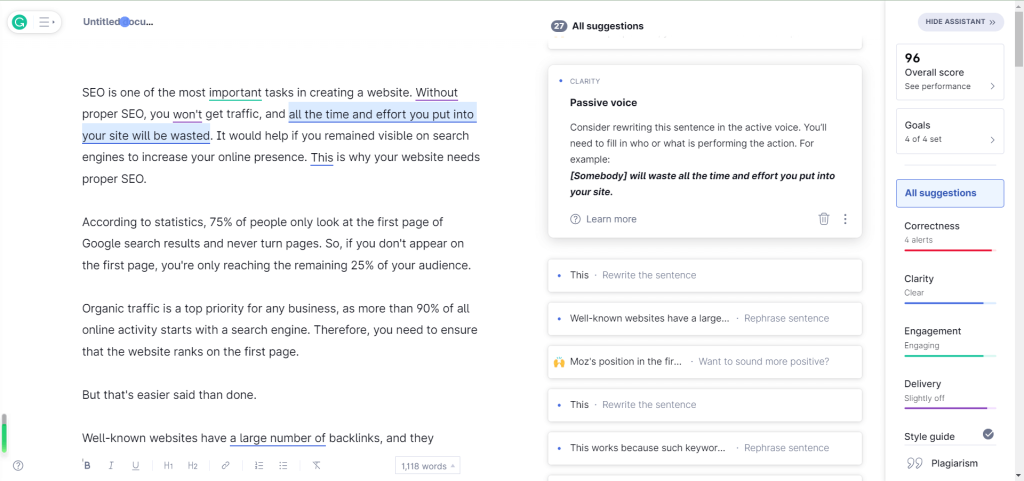
7. Promote Your Website-SEO
SEO is one of the most important tasks in creating a website. Without proper SEO, you won’t get traffic, and all the time and effort you put into your site will be wasted. It would help if you remained visible on search engines to increase your online presence. This is why your website needs proper SEO.
According to statistics, 75% of people only look at the first page of Google search results and never turn pages. So, if you don’t appear on the first page, you’re only reaching the remaining 25% of your audience.
Organic traffic is a top priority for any business, as more than 90% of all online activity starts with a search engine. Therefore, you need to ensure that the website ranks on the first page.
But that’s easier said than done.
Well-known websites have a large number of backlinks, and they generally occupy the first page of search engines.
Try it yourself. Do a Google search for “SEO guide” and see the results for yourself:
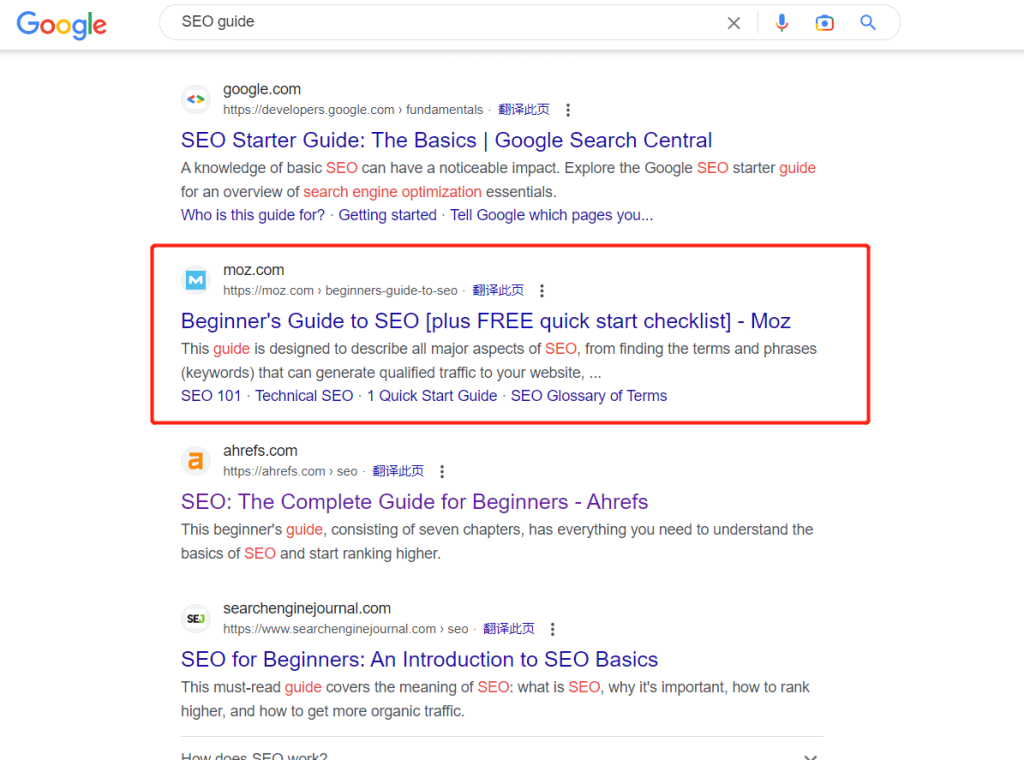
You can look at the Moz website, which has a Domain Authority of 93 and over 18,389 established links. Moz’s position in the first-page rankings is hard to beat.
So how do you squeeze in the front page?
Here are some SEO tips for this:
1. Long tail keywords
It’s essential to understand how people search online. According to statistics, more than 70% of users use long-tail keywords to search. You can use the keyword planner in Google’s AdWords to get more relevant long-tail keywords.
As you can see, searching with more descriptive phrases has advantages. For beginners, the cost and risk of doing so are relatively low, and the possibility of conversion is high.
Therefore, targeting long-tail phrases is a better strategy than short-tail phrases. In addition, long-tail keywords are also easier to rank for.
Amazon also utilizes this long-tail keyword strategy, contributing over 57% of sales. This works because such keywords are more specific than short-tail keywords and can sometimes confuse search engines.
2. Local SEO and market research
Here are some local SEO tips you should follow if you are a local business.
This involved creating a Google My Business listing, getting Google reviews, and customizing content for searches in the city. For example, targeted keywords on your page could include words like “best pizza in Detroit, Michigan” or “accounting firm in Chicago, IL.”
Market research is crucial in identifying suitable keywords for your business. Utilizing local SEO tools can assist in identifying important keywords.
Finding long-tail keywords that meet the customer’s search intent is especially important. For example, for a merchant engaged in the heavy metal industry, its keywords cannot be the same as those in the software industry. So you have to figure out the keywords unique to your industry.
3.On-page SEO
There are various techniques to achieve SEO for a website. You must know which elements of your website you can control and modify to improve your search engine rankings.
On-page SEO is a set of processes for optimizing the content of web pages and the site’s overall structure.
After market research, you will know the most important keywords you need. Using keywords in the title and first paragraph is a great trick. Adding keywords to the URL can also help.
Adding keywords throughout your site can help you get the attention you want. Some experts recommend that at least 0.5% to 2.5% of a website’s content should contain keywords.
The key point is that web pages and columns have unique descriptions and content. Otherwise, it will only confuse search engines and make them unable to distinguish other similar content. This can drag down SEO rankings.
Some crucial on-page SEO tips are listed below:
- Publish high-quality content
- Optimize the URL Slug and Meta tags of the webpage
- Headings and subheadings are well formatted
- Make web pages mobile-friendly
- Internal and external link optimization
- Optimize images and other multimedia elements
- Pay attention to page load speed
4.Off-page SEO
Off-page SEO is the art of optimizing SEO through content not on your website . For example, linking your website to high-authority pages generates a lot of traffic and greatly improves your website’s SEO ranking.
Certain other factors affect off-page SEO:
- Social media and influencer marketing
- Guest blogging
- Brand mentions
- Drain traffic through Youtube
5.Mobile optimization
A 2019 study states that over 48% of all web surfing globally occurs on mobile devices. Even Google has introduced mobile-first metrics, seeing mobile as an increasingly important platform for web activity. This emphasizes the mobile compatibility of the website. As a result, a mobile-optimized website will get better search engine rankings.
Some best practices for mobile-first indexing are given below:
- Use the same robot tag on your mobile site as your desktop site to make it easier for Googlebots to access and process your content.
- The mobile site should have the same content as the desktop site.
- Use the correct URL.
- Use high-quality images that are compatible with mobile sites.
- Verify both desktop and mobile sites in Search Console (Admin Tools).
6. Technical SEO and page speed
Since 2018, page speed has been a direct ranking factor in Google’s search engine algorithm. So, ensure your website has great load times and maintains optimal speed.
You also want to make sure that everything is tracked correctly when using Google Analytics on your website. It’s easy to set up Google Analytics and Search Console with almost any WordPress site, online store, website builder, or hosting plan.
Be sure to familiarize yourself with various Google Analytics SEO terms such as sessions, bounce rate, click-through rate (CTR), and more.
7. Image description
The Google search engine does not look at images as humans do. We rely on visual cues, while Google looks at descriptions and keywords to surface images. Adding appropriate descriptions to images and including necessary keywords will help Google display these images in image searches.
This can also help you direct traffic to your website and increase its attractiveness. Automated website builders generally make it easy to add descriptions to each image.
8. The structure is complete
Most search engines use bots to sniff around every corner of the website.
Their purpose is to understand the underlying format and structure of the website and thereby understand the overall hierarchy of the website.
A well-structured website will get a higher search ranking. Because a structured website also dramatically improves various metrics such as the number of page visits, click-through rate (CTR), average time on site, etc.
Using plugins such as AOISEO can help complete SEO optimization work, such as:
- Fast loading times
- Mobile optimization
- Google Index
- Structured data
- XML Sitemap
- Robots.txt file
- Minimal URL
- Default Meta Tag
8. Build an Email List
Email marketing remains one of the most profitable marketing channels with an ROI of 4200%, meaning that for every dollar you spend, you could earn back $42.
Aside from its profitability, email marketing enables businesses to reach more customers, boost sales, and enhance brand recognition.
Regardless of the industry, email marketing allows businesses to disseminate their marketing messages to the right audience and maintain a connection with their target audience long after they’ve left the website.
Building an email list can be a challenge, especially if you want to do it for free. But If you want to build a list quickly,paid ads are a big help.
Once you have a mailing list to which you can market, it’s important to use an email marketing service. For affiliate marketers, Getresponse is recommended since it offers great automation.
When setting up your email marketing campaign, starting with a 3-part autoresponder is a good idea:
The first email should highlight the features and logic of the product you’re promoting, provide a list of reasons why the product is beneficial, and include a testimonial to establish credibility.
The second email should tap into the reader’s emotions and help them visualize how their life would be better with the product.
The final email should create a sense of scarcity and encourage the reader to take action by using limited-time offers or other tactics.
It’s important to note that while these tactics can be effective, ethics should always be at the forefront of your marketing efforts. It’s crucial to ensure that the product you’re promoting actually delivers on its promises and helps the customer.
Overall, ethical and effective email marketing can be a powerful tool for selling your products or services.

Evaluate your email marketing needs based on the scale of your online business and industry, and select the best email marketing software that fits your requirements.
What are the best alternative tools to WordPress?
The demand for website building tools has increased, and there are now many options to choose from. There are many alternatives to WordPress on the market. The best of these are Squarespace, Weebly, and Wix.
Let’s take a look at these tools:
1.Weebly
Weebly is a well-liked website builder that offers flexible website design and a range of business tools to support business growth. It functions primarily as a drag-and-drop website builder that has undergone numerous upgrades over time, incorporating many fundamental features.
Professional and Performance plans come with a free custom domain name, saving you money. In addition, its user-friendly editor enables you to design your website effortlessly without requiring any technical expertise.
It is suitable for beginners or small business owners who want to create a simple website quickly.
Key features:
- Provides an integrated business platform.
- Mobile compatible.
- Responsive professional website theme.
- Built-in SEO tools to maximize customer contact.
- You can embed ready-made videos or embed your professional videos.
- Excellent free version.
Pricing:
It offers a free account. For business websites, pricing starts from $10 per month.
2. Squarespace
Squarespace provides an all-in-one solution for businesses to easily create visually appealing websites, including professional online stores and other website combinations. With over 100 preset templates, businesses can quickly create stunning and eye-catching sites.
Squarespace is utilized by over 3.7 million websites globally, offering a range of web conferences, forums, blogs, and help guides with comprehensive support. Its user-friendly interface makes it easy to adapt to and use.
It can be suitable for small to medium-sized businesses or individuals who want to create a more visually appealing website with more advanced features like e-commerce, blogging, or portfolio displays.
Its key features include:
- Customizable templates
- Free Typekit and Google Fonts
- Custom CSS
- Drag and drop management
- Join CDN, and the loading time is shortened
- Image SEO Image metadata import
- Gallery blocks and display effects
- Sound effects library
- Integrate third-party financial and marketing, sales tools, and transportation inventory management tools
- Dropbox file sync
- Social media integration
- Smart third-party service support
- Custom WYSIWYG editor
- Built-in SEO tools
Pricing:
Pricing ranges from $16/month to $49/month for an annual subscription.
3. Wix
Wix is a cloud-based website builder and web hosting service that allows users to create professional-looking websites without coding or technical knowledge. With Wix, users can create a website using a drag-and-drop interface and a variety of templates and design tools.
In addition to its website builder, Wix provides web hosting, domain registration, and other web-related services.
It is designed to be user-friendly and accessible, making it a popular choice for small business owners, entrepreneurs, freelancers, and individuals who want to create a personal website or online portfolio.
Wix offers a variety of features and tools to help users customize their website and add functionality, such as e-commerce tools, social media integration, mobile optimization, and SEO tools. It also has a built-in app market where users can add features and functionality to their website, such as contact forms, event calendars, and more.
Key features of Wix include:
- Customizable templates Wix ADI (Artificial Design Intelligence),
- Wix ADI automatically creates a customized website for them.
- App Market, users can add additional features and functionality to their website
- Mobile Optimization
- SEO Tools
- Custom Domain Names
- E-commerce Tools
- Blogging Tools
- Social Media Integration
Pricing:
Pricing ranges from $16/month to $45/month for an annual subscription.
Disclosur:Some of the links in this article may be affiliate links, which can provide compensation to me at no cost to you if you decide to purchase a paid plan.(No additional cost for you)
